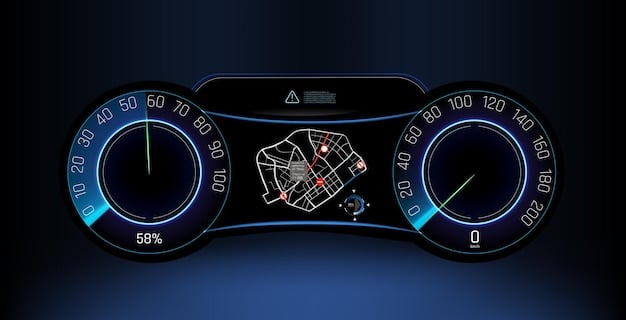ADAS Trends in US Vehicles: A Deep Dive into Advanced Driver-Assistance Systems

The key trends in the development of Advanced Driver-Assistance Systems (ADAS) in US vehicles include increased sensor integration, enhanced data processing, improved cybersecurity measures, greater connectivity, and a move towards more personalized and adaptive safety features.
The automotive industry is undergoing a massive transformation, and what are the key trends in the development of Advanced Driver-Assistance Systems (ADAS) in US vehicles is a crucial question. These systems are rapidly evolving, promising safer and more convenient driving experiences. Understanding these trends is essential for anyone involved in the automotive sector, from manufacturers to consumers.
Understanding the Evolution of ADAS in the US Market
Advanced Driver-Assistance Systems (ADAS) have quickly transitioned from futuristic concepts to essential features in modern vehicles. In the US market, this evolution is marked by increasing sophistication, integration, and affordability. Understanding this journey is key to appreciating the current trends.
ADAS technologies initially focused on basic safety features like anti-lock brakes and electronic stability control. Today, they encompass a wide range of functionalities designed to prevent accidents and enhance driver comfort.
Early ADAS Implementations
The first wave of ADAS features included technologies like:
- Adaptive Cruise Control (ACC): Maintains a safe following distance from the vehicle ahead.
- Lane Departure Warning (LDW): Alerts the driver when the vehicle drifts out of its lane.
- Automatic Emergency Braking (AEB): Automatically applies the brakes to avoid or mitigate collisions.
These early implementations were often limited in their capabilities and relied on single-sensor systems. However, they paved the way for more advanced and integrated solutions.

The evolution of ADAS is not just about adding more features; it’s about improving their reliability, accuracy, and seamless integration into the driving experience. This requires advancements in sensor technology, data processing, and software algorithms. The US market is at the forefront of this evolution, driven by stringent safety regulations and consumer demand for advanced technologies.
The Rise of Sensor Fusion in ADAS
Sensor fusion is a critical trend in the development of ADAS. It involves combining data from multiple sensors, such as radar, cameras, and lidar, to create a more comprehensive and accurate understanding of the vehicle’s surroundings. Here’s why it’s important:
By integrating data from various sources, sensor fusion overcomes the limitations of individual sensors, resulting in more reliable and robust ADAS performance.
Benefits of Sensor Fusion
Sensor fusion offers several key advantages:
- Enhanced Accuracy: Combining data from multiple sensors reduces errors and improves the accuracy of object detection and tracking.
- Improved Reliability: If one sensor fails or is obstructed, the system can still function using data from other sensors.
- Wider Field of View: Different sensors have different fields of view, and sensor fusion allows for a more comprehensive understanding of the vehicle’s surroundings.
This technology is essential for enabling advanced ADAS features like traffic jam assist, automatic lane centering, and pedestrian detection. The integration of these sensors results in a safer and more reliable driving experience.
The US market is witnessing significant investments in sensor fusion technologies, with automotive manufacturers and technology companies collaborating to develop innovative solutions. This trend is expected to accelerate as vehicles become more autonomous.
Cybersecurity: Protecting ADAS from Threats
As ADAS become more sophisticated and connected, cybersecurity is becoming a critical concern. Protecting these systems from cyberattacks is essential to ensure the safety and reliability of vehicles.
Cybersecurity threats to ADAS can range from simple disruptions to malicious attempts to control vehicle functions. Addressing these threats requires a multi-layered approach that includes secure hardware, software, and communication protocols.
Key Cybersecurity Measures
Several measures are being implemented to protect ADAS from cyberattacks:
- Intrusion Detection and Prevention Systems: Monitor vehicle networks for suspicious activity and block unauthorized access.
- Secure Over-the-Air (OTA) Updates: Ensure that software updates are authenticated and encrypted to prevent tampering.
- Hardware Security Modules (HSMs): Protect sensitive data and cryptographic keys from unauthorized access.
These measures are crucial for maintaining the integrity and safety of ADAS, especially as vehicles become more connected and autonomous. The need for robust cybersecurity is driving innovation in the automotive industry.

The US government and industry organizations are also working together to develop cybersecurity standards and best practices for the automotive industry. This collaborative effort is essential to address the evolving cybersecurity landscape and protect vehicles from emerging threats.
The Role of Connectivity in Enhancing ADAS
Connectivity is playing an increasingly important role in enhancing ADAS. By connecting vehicles to the internet and to each other, ADAS can access real-time traffic information, weather updates, and other data that can improve their performance and safety.
Connected ADAS can proactively adapt to changing conditions, providing drivers with timely warnings and assistance. This connectivity also enables over-the-air (OTA) updates, allowing manufacturers to continuously improve and enhance ADAS features.
Benefits of Connected ADAS
Connectivity offers several benefits for ADAS:
- Real-Time Traffic Information: ADAS can use real-time traffic data to adjust speed and routing, avoiding congestion and reducing travel time.
- Weather Updates: ADAS can use weather data to adjust vehicle settings and provide warnings about hazardous conditions.
- Cooperative ADAS: Vehicles can share information with each other to improve situational awareness and coordinate actions.
The deployment of 5G networks is further accelerating the adoption of connected ADAS, enabling faster data transfer rates and lower latency. This is essential for supporting advanced features like platooning and remote control.
The US market is witnessing significant investments in connected car technologies, with major telecommunications companies and automotive manufacturers partnering to develop innovative solutions. This trend is expected to transform the driving experience and pave the way for fully autonomous vehicles.
Personalization and Adaptability in ADAS
One of the emerging trends in ADAS is the move towards more personalized and adaptive safety features. These systems are designed to learn driver preferences and adapt their behavior accordingly, providing a more tailored and intuitive driving experience.
Personalized ADAS can adjust settings like following distance, lane centering sensitivity, and speed limits based on individual driver habits and preferences. This customization enhances driver comfort and satisfaction while maintaining a high level of safety.
Examples of Personalized ADAS
Here are some examples of personalized ADAS features:
- Driver Profiles: Allowing drivers to save their preferred ADAS settings and automatically load them when they start the vehicle.
- Adaptive Learning: ADAS that learn driver habits and adjust their behavior over time to better suit individual driving styles.
- Context-Aware Systems: ADAS that adapt their behavior based on the driving environment, such as urban areas, highways, or rural roads.
This level of personalization requires sophisticated algorithms and data analytics, as well as robust privacy and security measures. The US market is at the forefront of developing these technologies, driven by consumer demand for more customized driving experiences.
The future of ADAS is likely to involve even greater levels of personalization, with systems that can anticipate driver needs and proactively adjust vehicle settings to optimize safety and comfort. This will require continuous innovation in sensor technology, data processing, and artificial intelligence.
The Path to Fully Autonomous Vehicles
While ADAS are not fully autonomous systems, they represent a crucial step on the path towards self-driving vehicles. The advancements in ADAS technology are laying the foundation for the development of fully autonomous vehicles, which promise to revolutionize transportation.
Fully autonomous vehicles will require even more sophisticated sensors, data processing capabilities, and software algorithms than current ADAS. They will also need to be able to operate safely and reliably in a wide range of conditions, without human intervention. The development of these technologies is a complex and challenging undertaking.
Key Challenges in Achieving Full Autonomy
Several key challenges must be addressed to achieve full autonomy:
- Sensor Reliability: Ensuring that sensors can accurately and reliably detect and classify objects in all weather conditions.
- Data Processing: Developing algorithms that can process vast amounts of data in real-time and make decisions that are as safe as, or safer than, human drivers.
- Cybersecurity: Protecting autonomous vehicles from cyberattacks that could compromise their safety and security.
Despite these challenges, significant progress is being made in the development of autonomous vehicle technology. The US market is at the forefront of this innovation, with major technology companies and automotive manufacturers investing billions of dollars in research and development.
| Key Trend | Brief Description |
|---|---|
| 🚗 Sensor Fusion | Integrating data from radar, cameras, and lidar for enhanced accuracy. |
| 🛡️ Cybersecurity | Protecting ADAS from cyber threats with advanced security measures. |
| 🌐 Connectivity | Using real-time data and OTA updates to improve ADAS performance. |
| ⚙️ Personalization | Adapting ADAS to driver preferences for a tailored experience. |
Frequently Asked Questions
▼
ADAS are electronic systems in vehicles designed to enhance safety by automating, adapting, and improving vehicle systems. They aim to reduce human error, prevent accidents, and make driving more comfortable.
▼
Sensor fusion combines data from multiple sensors like radar, lidar, and cameras to create a more accurate and reliable understanding of the vehicle’s surroundings, improving object detection and reducing errors.
▼
Cybersecurity is crucial to protect ADAS from cyberattacks that could compromise vehicle safety, disrupt system functionality, or allow unauthorized control of vehicle functions.
▼
Connectivity enables ADAS to access real-time traffic and weather information, receive over-the-air updates, and share data with other vehicles, improving overall performance and safety.
▼
ADAS are becoming more personalized by learning driver preferences, adjusting settings based on individual driving styles, and adapting to the driving environment to provide a tailored driving experience.
Conclusion
The trends in ADAS development in US vehicles signify a strong push towards safer, smarter, and more connected driving experiences. As technology evolves, these systems will not only prevent accidents but also adapt to individual driver needs, paving the way for a future where driving is both secure and personalized.





